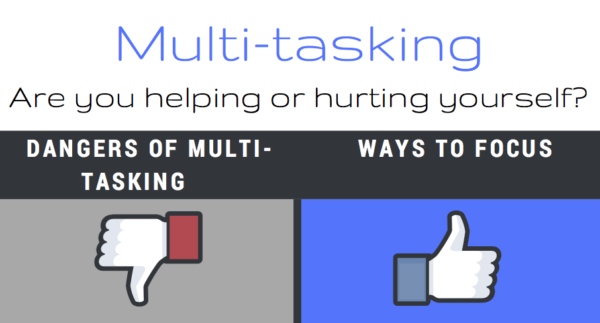I can remember, in my first leadership role, telling my direct reports they needed to get better at multitasking.
Critical pieces of work weren’t done when they needed to be. I required staff to complete parts of one project and then move to a piece of a different project rather than finishing one project from start to finish. In retrospect, what I really wanted was for them to work on things in priority order.
While we’re on the subject of priorities, here’s another post you’ll want to read next: Have your priorities shifted? How to go from “On hold” to “Completed” even in these uncertain times.
The Dangers of Multitasking
They didn’t need to multitask. Instead, I needed to communicate what the priorities and deadlines were.
But that was 20 years ago. And 20 years ago, I was a brand new leader. And, as a society, we were bragging about our ability to multitask.
In fact, “ability to multi-task” was one of the top required skills on job postings.
Fast forward to today and we have an interesting paradox of knowing that multitasking doesn’t work and is, in fact, bad for us. We also now have a society that multi-tasks more than any other time in history. Just look at the number of people looking at their iPhones while walking, eating in a restaurant, driving, ‘watching’ their kid’s sports event – and doing pretty much anything.
I originally planned to write a blog on multitasking, as it is a contributor to so many workplace incidents I have investigated over the years. (Read about our workplace investigation services here) It leads to not only safety incidents and policy violations but also issues you wouldn’t think relate to multi-tasking such as conflicts due to misunderstood communication.
After all, how many of us haven’t continued typing away when we answer the phone?
I knew many of the downsides and that multi-tasking simply isn’t as effective as single-tasking, but I wanted to get up to speed on the latest research in the area. What I learned scared and saddened me.
I was surprised by how much scientific research there is now on how multitasking actually reprograms our brain…and not for the better. It also prevents or destroys quality relationships, causes us to overeat, stifles creativity, causes memory problems, makes us sad, stressed and much more.
Be sure to read this post on how multitasking can be a mental and medical hazard from the Harvard Health Blog.
How to Succeed at Single-Tasking
Through my research, I realized we don’t need another blog on multitasking. What would be helpful, however, is a simple, practical tool for succeeding in single-tasking. We love infographics here at ACTivate HR.
And we want everyone to be successful. So, we’ve created an infographic for you to download and pin up where you can see it as a reminder. The infographic summarizes the main negative effects of multitasking. But we didn’t stop there. We wanted to provide you with helpful alternatives right alongside the negative effects of multitasking. That’s why it also provides a list of tips on how you can succeed in single-tasking.
Resist the pull to read the email, answer the phone, or do whatever other distraction arises while reading this infographic! You can download the pop-up box in the bottom right corner of this page.
Did you learn a lot about the dangers of multitasking in this post?
Here are three posts to read next:
- Are You Using Technology to Avoid Communicating?
- Employees Resisting Change? Here’s Why…and How to Engage Them
- Toxic Workplace Culture: 5 Ways to Tell If It’s Poisoning You
This post was first published in 2017 but it was updated in 2021 just for you.

